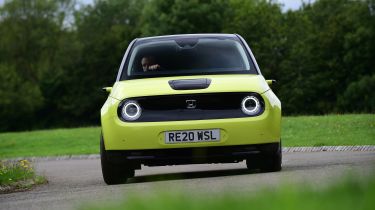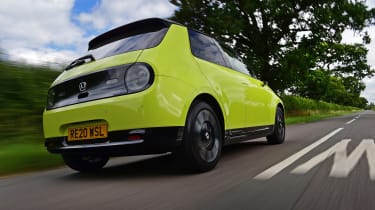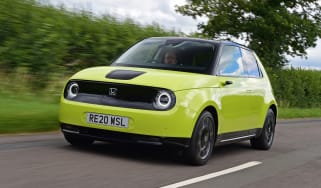Honda e hatchback review - Electric motor, drive & performance (2020-2024)
The Honda e is very manoeuvrable but its talents don’t end there
The compact size of the Honda e makes it a perfect fit in tight streets and its rear-wheel-drive layout combined with the absence of an engine or electric motor in the front means the front wheels can turn to ridiculous angles. The 4.3-metre turning circle is smaller than a London taxi - a vehicle specifically designed to make the famously tight turn outside the Savoy hotel.
A sizeable amount of torque (all of it available instantly) means the Honda e excels at nipping away from traffic lights and junctions. The e can zip through traffic and feels at home in built-up areas.
Take it out of the city limits and you’ll find it’s happy on twistier roads, too. It may be a short car but the wheels are pushed right out into each corner and it feels impressively stable as a result. The steering has a good amount of feel, so you never feel disconnected from the action like you can do in some other EVs. At speed, the front wheels do start to push wide through corners, which can occasionally make the car feel a little nervous, but overall it’s more fun to drive than the Peugeot e-208. Grippy Michelin Pilot Sport 4 tyres help here; they're usually fitted to sporty machinery rather than electric eco cars.
More reviews
In-depth reviews
One thing to note is the number of brake regeneration settings you have at your disposal. There are four to cycle through if you use the steering wheel-mounted paddles, and then another three unlocked if you push the ‘single pedal’ button, which lets you drive mostly just using the accelerator (the car will slow down dramatically when you take your foot off). Single pedal driving is familiar from cars such as the Nissan Leaf and it’s good to have it in the Honda e, but the sheer number of modes and settings is a little on the high side for a car that’ll spend most of its time in the city.
Honda e electric motor
The Honda e was designed from the ground up to be an electric car and there are no petrol or diesel versions. It’s Honda’s first battery-powered EV (in America it sells a hydrogen-powered car), uses a bespoke platform and is the only rear-wheel-drive model in the range.
Both versions of the Honda e use a 35.5kWh battery and one electric motor, but the trim levels have slightly different power outputs. The standard model produces 134bhp and manages 0-62mph in nine seconds flat, while the Advance model gets 152bhp and a slightly quicker acceleration time, at 8.3 seconds. That’s almost as quick as the more powerful Nissan Leaf, and quicker than a Volkswagen e-up!. Top speed is 90mph whichever model you choose.
As with most smaller EVs, it's the 0-30mph acceleration that impresses most, and you can just about tell that the e is being pushed from the rear rather than being pulled by the front tyres. Sport mode sharpens throttle response a touch when you want to prioritise performance.














